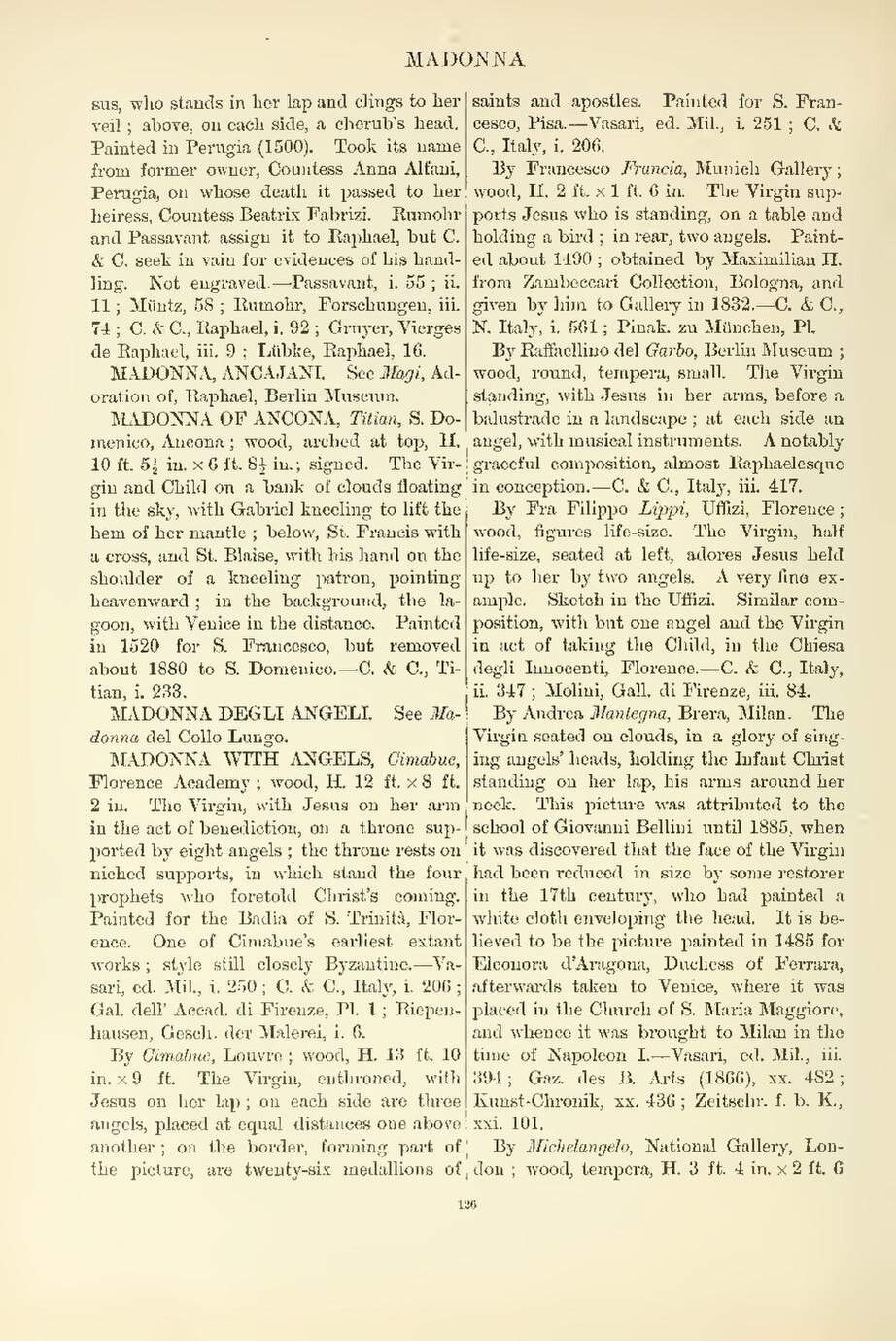- sus, who stands in her lap and clings to her
veil; above, on each side, a cherub's head. Painted in Perugia (1500). Took its name from former owner, Countess Anna Alfani, Perugia, on whose death it passed to her heiress, Countess Beatrix Fabrizi. Rumohr and Passavant assign it to Raphael, but C. & C. seek in vain for evidences of his handling. Not engraved.—Passavant, i. 55; ii. 11; Müntz, 58; Rumohr, Forschungen, iii. 74; C. & C., Raphael, i. 92; Gruyer, Vierges de Raphael, iii. 9; Lübke, Raphael, 16.
MADONNA, ANCAJANI. See Magi, Adoration
of, Raphael, Berlin Museum.
MADONNA OF ANCONA, Titian, S. Domenico,
Ancona; wood, arched at top, H.
10 ft. 5-1/2 in. × 6 ft. 8-1/2 in.; signed. The Virgin
and Child on a bank of clouds floating
in the sky, with Gabriel kneeling to lift the
hem of her mantle; below, St. Francis with
a cross, and St. Blaise, with his hand on the
shoulder of a kneeling patron, pointing
heavenward; in the background, the lagoon,
with Venice in the distance. Painted
in 1520 for S. Francesco, but removed
about 1880 to S. Domenico.—C. & C., Titian,
i. 233.
MADONNA DEGLI ANGELI. See Madonna
del Collo Lungo.
MADONNA WITH ANGELS, Cimabue,
Florence Academy; wood, H. 12 ft. × 8 ft.
2 in. The Virgin, with Jesus on her arm
in the act of benediction, on a throne supported
by eight angels; the throne rests on
niched supports, in which stand the four
prophets who foretold Christ's coming.
Painted for the Badia of S. Trinità, Florence.
One of Cimabue's earliest extant
works; style still closely Byzantine.—Vasari,
ed. Mil., i. 250; C. & C., Italy, i. 206;
Gal. dell' Accad. di Firenze, Pl. 1; Riepenhausen,
Gesch. der Malerei, i. 6.
By Cimabue, Louvre; wood, H. 13 ft. 10 in. × 9 ft. The Virgin, enthroned, with Jesus on her lap; on each side are three angels, placed at equal distances one above another; on the border, forming part of the picture, are twenty-six medallions of saints and apostles. Painted for S. Francesco, Pisa.—Vasari, ed. Mil., i. 251; C. & C., Italy, i. 206.
By Francesco Francia, Munich Gallery; wood, H. 2 ft. × 1 ft. 6 in. The Virgin supports Jesus who is standing, on a table and holding a bird; in rear, two angels. Painted about 1490; obtained by Maximilian II. from Zambeccari Collection, Bologna, and given by him to Gallery in 1832.—C. & C., N. Italy, i. 561; Pinak. zu München, Pl.
By Raffaellino del Garbo, Berlin Museum; wood, round, tempera, small. The Virgin standing, with Jesus in her arms, before a balustrade in a landscape; at each side an angel, with musical instruments. A notably graceful composition, almost Raphaelesque in conception.—C. & C., Italy, iii. 417.
By Fra Filippo Lippi, Uffizi, Florence; wood, figures life-size. The Virgin, half life-size, seated at left, adores Jesus held up to her by two angels. A very fine example. Sketch in the Uffizi. Similar composition, with but one angel and the Virgin in act of taking the Child, in the Chiesa degli Innocenti, Florence.—C. & C., Italy, ii. 347; Molini, Gall. di Firenze, iii. 84.
By Andrea Mantegna, Brera, Milan. The Virgin seated on clouds, in a glory of singing angels' heads, holding the Infant Christ standing on her lap, his arms around her neck. This picture was attributed to the school of Giovanni Bellini until 1885, when it was discovered that the face of the Virgin had been reduced in size by some restorer in the 17th century, who had painted a white cloth enveloping the head. It is believed to be the picture painted in 1485 for Eleonora d'Aragona, Duchess of Ferrara, afterwards taken to Venice, where it was placed in the Church of S. Maria Maggiore, and whence it was brought to Milan in the time of Napoleon I.—Vasari, ed. Mil., iii. 394; Gaz. des B. Arts (1866), xx. 482; Kunst-Chronik, xx. 436; Zeitschr. f. b. K., xxi. 101.
By Michelangelo, National Gallery, London; wood, tempera, H. 3 ft. 4 in. × 2 ft. 6
